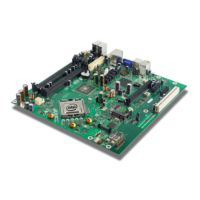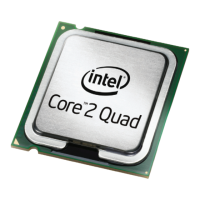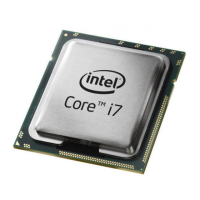Electrical Specifications
22 Datasheet
2.6 Signaling Specifications
Most processor Front Side Bus signals use Gunning Transceiver Logic (GTL+) signaling
technology. This technology provides improved noise margins and reduced ringing
through low voltage swings and controlled edge rates. Platforms implement a
termination voltage level for GTL+ signals defined as V
TT
. Because platforms implement
separate power planes for each processor (and chipset), separate V
CC
and V
TT
supplies
are necessary. This configuration allows for improved noise tolerance as processor
frequency increases. Speed enhancements to data and address busses have caused
signal integrity considerations and platform design methods to become even more
critical than with previous processor families.
The GTL+ inputs require a reference voltage (GTLREF) which is used by the receivers to
determine if a signal is a logical 0 or a logical 1. GTLREF must be generated on the
motherboard (see Table 14 for GTLREF specifications). Termination resistors (R
TT
) for
GTL+ signals are provided on the processor silicon and are terminated to V
TT
. Intel
chipsets will also provide on-die termination, thus eliminating the need to terminate the
bus on the motherboard for most GTL+ signals.
2.6.1 FSB Signal Groups
The front side bus signals have been combined into groups by buffer type. GTL+ input
signals have differential input buffers, which use GTLREF[3:0] as a reference level. In
this document, the term “GTL+ Input” refers to the GTL+ input group as well as the
GTL+ I/O group when receiving. Similarly, “GTL+ Output” refers to the GTL+ output
group as well as the GTL+ I/O group when driving.
With the implementation of a source synchronous data bus comes the need to specify
two sets of timing parameters. One set is for common clock signals which are
dependent upon the rising edge of BCLK0 (ADS#, HIT#, HITM#, etc.) and the second
set is for the source synchronous signals which are relative to their respective strobe
lines (data and address) as well as the rising edge of BCLK0. Asychronous signals are
still present (A20M#, IGNNE#, etc.) and can become active at any time during the
clock cycle. Table 7 identifies which signals are common clock, source synchronous,
and asynchronous.
Table 7. FSB Signal Groups (Sheet 1 of 2)
Signal Group Type Signals
1
GTL+ Common
Clock Input
Synchronous to
BCLK[1:0]
BPRI#, DEFER#, RESET#, RS[2:0]#, TRDY#
GTL+ Common
Clock I/O
Synchronous to
BCLK[1:0]
ADS#, BNR#, BPM[5:0]#, BPMb[3:0]#, BR0#, DBSY#,
DRDY#, HIT#, HITM#, LOCK#
GTL+ Source
Synchronous I/O
Synchronous to
assoc. strobe
GTL+ Strobes
Synchronous to
BCLK[1:0]
ADSTB[1:0]#, DSTBP[3:0]#, DSTBN[3:0]#
Signals Associated Strobe
REQ[4:0]#, A[16:3]#
3
ADSTB0#
A[35:17]#
3
ADSTB1#
D[15:0]#, DBI0# DSTBP0#, DSTBN0#
D[31:16]#, DBI1# DSTBP1#, DSTBN1#
D[47:32]#, DBI2# DSTBP2#, DSTBN2#
D[63:48]#, DBI3# DSTBP3#, DSTBN3#

